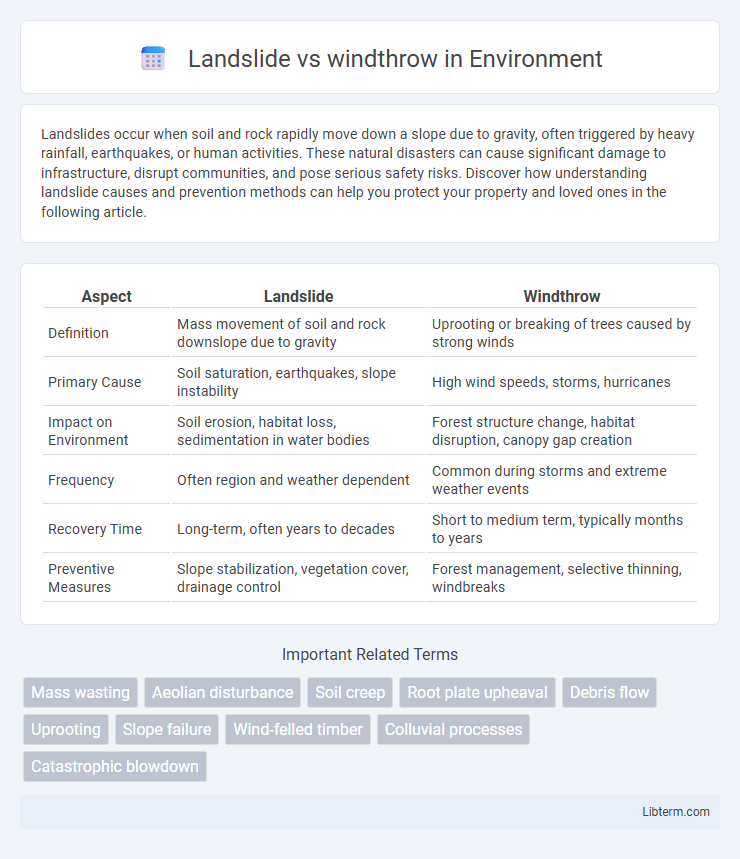Landslides occur when soil and rock rapidly move down a slope due to gravity, often triggered by heavy rainfall, earthquakes, or human activities. These natural disasters can cause significant damage to infrastructure, disrupt communities, and pose serious safety risks. Discover how understanding landslide causes and prevention methods can help you protect your property and loved ones in the following article.
Table of Comparison
| Aspect | Landslide | Windthrow |
|---|---|---|
| Definition | Mass movement of soil and rock downslope due to gravity | Uprooting or breaking of trees caused by strong winds |
| Primary Cause | Soil saturation, earthquakes, slope instability | High wind speeds, storms, hurricanes |
| Impact on Environment | Soil erosion, habitat loss, sedimentation in water bodies | Forest structure change, habitat disruption, canopy gap creation |
| Frequency | Often region and weather dependent | Common during storms and extreme weather events |
| Recovery Time | Long-term, often years to decades | Short to medium term, typically months to years |
| Preventive Measures | Slope stabilization, vegetation cover, drainage control | Forest management, selective thinning, windbreaks |
Understanding Landslides: Key Concepts
Landslides involve the mass movement of soil, rock, and debris down a slope due to gravity, often triggered by factors like heavy rainfall, earthquakes, or human activities destabilizing the terrain. Windthrow refers to trees uprooted or broken by strong winds but does not entail the movement of large soil masses typical in landslides. Understanding landslides requires analyzing slope stability, soil composition, water saturation, and external triggers that lead to slope failure, differentiating them clearly from windthrow events primarily caused by atmospheric forces.
Defining Windthrow: Nature’s Tree Uprooting Force
Windthrow refers to the natural phenomenon where strong winds uproot or break trees, causing significant forest disturbance and altering ecosystems. This event differs from landslides, which involve the movement of soil and rock down a slope, often triggered by rain or seismic activity rather than wind. Understanding windthrow helps in forest management and assessing the impact of storms on tree stability and habitat structure.
Geological Triggers Behind Landslides
Landslides primarily occur due to geological triggers such as soil saturation from heavy rainfall, seismic activity causing ground shaking, and the inherent instability of steep slopes composed of loose or weathered materials. In contrast, windthrow is caused by strong winds uprooting trees, which affects vegetation but not the geological substrate directly. Understanding the geological triggers behind landslides is critical for assessing slope stability and implementing effective hazard mitigation strategies.
Meteorological Factors Influencing Windthrow
Meteorological factors influencing windthrow primarily include high wind speeds, storm frequency, and precipitation patterns, which weaken tree stability and increase susceptibility to uprooting. Prolonged drought can reduce soil moisture, compromising root anchorage, while saturated soils from heavy rainfall reduce soil cohesion, facilitating tree fall during storms. Windthrow is thus strongly correlated with extreme weather events, such as hurricanes and severe thunderstorms, where combined wind force and soil conditions trigger widespread tree damage.
Environmental Impact: Landslides vs Windthrow
Landslides cause rapid soil displacement, leading to habitat destruction, water pollution, and increased sedimentation in rivers, severely impacting aquatic ecosystems. Windthrow results in uprooted trees and canopy gaps that alter forest microclimates and nutrient cycling, often promoting biodiversity through habitat heterogeneity. Both events disrupt ecosystem stability but differ in scale and recovery dynamics, with landslides causing more immediate landscape alteration and windthrows fostering gradual ecological succession.
Common Warning Signs and Risk Assessment
Common warning signs of landslides include cracks in the soil, tilted trees, and sudden changes in water flow, while windthrow is often preceded by loosened or uprooted trees and saturated soils caused by heavy rainfall. Risk assessment for landslides involves analyzing slope stability, soil composition, and rainfall patterns, whereas windthrow risk focuses on tree species susceptibility, wind speeds, and forest stand structure. Both hazards require monitoring environmental changes and historical data to predict potential events accurately.
Landform Changes: Comparing Physical Effects
Landslides cause rapid downslope movement of soil and rock, drastically reshaping terrain by creating scarps, displaced debris, and altered drainage patterns. Windthrow involves the uprooting or breakage of trees by strong winds, leading to localized changes such as canopy gaps and soil disturbance but generally less extensive landform alteration. While landslides result in significant geomorphological transformation, windthrow primarily affects forest structure with modest impact on overall landform configuration.
Ecosystem Consequences of Both Phenomena
Landslides cause rapid soil displacement and vegetation loss, significantly disrupting habitat structure and nutrient cycling, leading to long-term changes in ecosystem composition. Windthrow results in uprooted or broken trees that create gaps in forest canopies, enhancing light penetration and promoting biodiversity through increased plant regeneration. Both phenomena alter hydrological pathways and soil properties, but landslides typically lead to more severe erosion and sediment deposition in aquatic systems compared to the localized disturbances caused by windthrow.
Prevention and Mitigation Strategies
Landslide prevention involves slope stabilization techniques such as retaining walls, drainage control, and vegetation reinforcement to reduce soil erosion and water infiltration. Windthrow mitigation prioritizes forest management practices like selective thinning, planting wind-resistant tree species, and maintaining biodiversity to enhance forest resilience. Both strategies emphasize early warning systems and monitoring to detect risk factors and enable timely response measures.
Case Studies: Notable Landslides and Windthrow Events
The 2018 Montecito landslide in California caused significant devastation with rapid debris flow following heavy rainfall, highlighting the destructive potential of such slope failures. Notable windthrow events include the 2005 European windstorm Kyrill, which resulted in extensive uprooting of trees across Germany and neighboring countries, severely impacting forest ecosystems and timber industries. These case studies illustrate the contrasting mechanisms and impacts of landslides and windthrows, emphasizing the importance of regional geological and meteorological conditions in their occurrence.
Landslide Infographic

 libterm.com
libterm.com